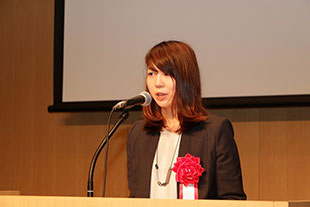 The 17th Asia Pacific Research Prize (Iue Prize) “Commendation” winner: Dr. Saki Kinnan
The 17th Asia Pacific Research Prize (Iue Prize) “Commendation” winner: Dr. Saki Kinnan
Title of Dissertation: “A Sociological Study on Multicultural Coexistence in a Contact Zone: Focusing on Social Practices around a Gaikokujingakko (Foreign School)”

- Dr. Saki Kinnan
-
- Career -
Saki Kinnan is a Doctor of Human Sciences, specializing in Sociology of Education. In March 2013, she graduated from an undergraduate program at the School of Human Sciences at Osaka University, and in April of the same year, she entered one of its Master’s degree programs. She has been a Research Fellow at the Japan Society for the Promotion of Science since 2015. In March 2018, she completed the Doctoral Program at the Osaka University Graduate School of Human Sciences, and since April of the same year, she has been working as an Assistant Professor at the Faculty of Global Communication at Aichi Shukutoku University.
- Summary -
This study discusses and analyzes contacts between various subjects, which have been seen in the relevant local community since the establishment of a gaikokujingakko (foreign school), and the processes of their mutual changes. By doing so, the study aims to clarify the dynamics of the creation and development of multicultural coexistence and its logical background.Specifically, a qualitative survey was conducted targeting the newly established Korean ethnic school “T” and its surrounding area (where various sociocultural groups live together, including a Japanese minority group called the buraku people and a Muslim group associated with a mosque). Based on the survey, educational and social practices that have been seen for the 10 years since the establishment of School T were analyzed. The analysis was made using the concept of “contact zone” (Pratt ?1992? 2008), which aims to grasp the effects of contacts between people in dominant and subordinate groups and their asymmetrical but fluid relations.
In the introduction, previous studies are discussed with this study being positioned between sociology of education and urban sociology, and a survey outline is then introduced in Chapter 1. In Chapter 2, the background factors of an opposition campaign carried out by some local residents at the time of the establishment of School T and the impact of the campaign on the local community are clarified. In Chapter 3, contacts between School T and various public schools in the local community that have been seen since the launch of the opposition campaign and the processes of their mutual changes are depicted based on the narratives of teachers at individual schools. In Chapter 4, the reasons why local children chose to attend School T, their experiences after their admission to the school, and the impacts of their admission on their surroundings are clarified. In Chapter 5, based on the life history of a teacher at School T, the processes of self-changes that he experienced through contacts with the local community are discussed. In Chapter 6, contacts between School T, a human rights movement group, and a Muslim group associated with a mosque and the processes of their mutual changes are clarified especially by focusing on how “the discourse on multicultural coexistence” is generated and used by them.
In the final chapter, findings provided in each chapter are organized, and the dynamics of the creation and development of multicultural coexistence and its logical background in terms of the following seven elements are discussed: 1) a given condition of “thrown togetherness,” 2) subjectivation induced through mutual contacts, 3) the creation of solidarity based on minority status, 4) changes in awareness, practices, and relationships, 5) the complex development of conflicts and solidarity, 6) the visualization of subjects positioned between each category leading to the further activation of mutual changes, and 7) the reorganization of local aggregation based on the educational network. Finally, the academic contribution of this study to previous studies in sociology of education and urban sociology is presented.






